Moschopolis / Albania : the Head Office of Macedonarmân Council
 A short history of Moschopolis
A short history of Moschopolis
The history of Moschopolis (Albanian „Voskopoje“, Macedonarmân „Moscopolea“), the major city in the Balkans during the 18th century, counting ca. 60,000 to 70,000 inhabitants, is situated at an altitude of ca. 1200 m above the sea level. Surrounded by mountains, Moscopole is located 25 km far from Korce (in Macedonarmân, „Curceaua“), a city counting ca. 40,000 inhabitants.
During the 18th century, Moschopolis was located at the crossroads of a significant commerce route, which extended from Venice to Odesa. According to numerous old sources, the city was founded by Macedonarmâns and was mostly inhabited by these towards the middle of the 18th century, despite the fact that some have questioned the ethnical procentual classification. Nowadays, due to its altitude, the city is well-known as a winter sports as well as a climatic spa resort. It is inhabited by only ca. 1000 people.
Much more earlier, previous to the economic progress in the 18th century, apparently already in the 14th century, the first church was built. It was followed by the three naves basilica at the beginning of the 18th century, in 1712. In the 20s of the 18th century, the Macedonarmân churches, Saint Thanas and Saint Nikola, decorated with frescos, began to be built.
Not only the church architecture has been influenced by the city economic progress in its prosperous years.
In Moschopolis the first print office was founded, which has printed more than 20 prints.
Also the Moschopolis School was established, later on known as Nea Akademia, whose head
was Theodor Anastasiu Cavallioti.
Moschopolis was the most important center of the Balkans in the 18th century, being the second city of the Balkans not only in population but also in prosperity, surpassed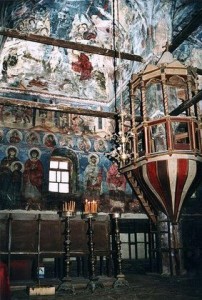 only by Istanbul at the time.
only by Istanbul at the time.
Until 1788, Moschopolis was inhabited almost exclusively by Macedonarmâns, there were also some Greek, Bulgarian, and Albanian traders.
In his work „Untersuchungen über die Geschichte der östlichen europäischen Völker“, Leipzig 1774, Johann Thunmann wrote that, everyone in the city spoke Armân, many also spoke Greek, the language used for commerce.
There were various manufacturing plants, many churches and banks, a printing press, a university and an academy (The New Academy, founded in 1744).
A cultural life began to arise in Moschopolis, many authors published their works here in Greek, the civilised language of the Balkans at the time, but also in Armân using Greek alphabet.
Beginning with the year 1769 the series of Ottomans attacks on Moschopolis started which culminated with its obliteration by the troops of Ali Pasha in 1788.
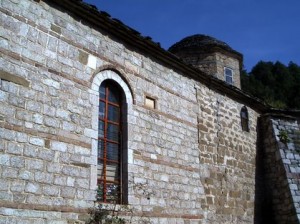 The survivors were forced to flee, most of them to Greece, Serbia, Bulgaria and Romania, most of the commerce elite moved to Austrian-Hungarian Empire, to Vienna and Budapest.
The survivors were forced to flee, most of them to Greece, Serbia, Bulgaria and Romania, most of the commerce elite moved to Austrian-Hungarian Empire, to Vienna and Budapest.
The dictionary of four Balkan languages (Greek „Romeika“, Macedonarmân „Vlahika“, Bulgarian and Albanian) was compiled by Daniil Moscopoleanlu (Daniil Mihali Adami Hagi), professor and director of New Akademy School of Moscopole in the 18th century.
The dictionary was printed at the begining of the 19th century.
Picot wrote on Cavallioti’s book („Protopiria“): “ le moment le plux precieux que nous possedions sur le dialecte macédonien“[n.n-the Macedonarmân language].Protopiria was the forerunner of comparative linguistics in the Balkans.
MINAREA CULTURALÂ DI MOSCOPOLE
S-anyrâpsi multu tr-aestâ minari ma nu s-featsi pânâ tora unâ câftari ahândoasâ, nauâ alushtui fenomenu culturalu balcanicu shi evropeanu.
Tsi haractiru ari aestâ minari? Easti mashi gârtseascâ, cumu dzâcu Gretslji? Câtu easti armâneascâ? Shi ma intirisantu easti s-videmu tu aestâ minari unâ protâ ahurheari di amintari a spiritlui evropeanu tu Balcanu.
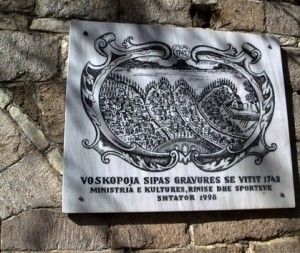 Ashi cumu Bizantsulu nu fu mashi gârtsescu (a s-hibâ câ tuti anyrâpserili suntu tu greacâ) tutu ashi minarea culturalâ di Moscopole nu poartâ damca mashi ali unâ culturâ. Moscopole deadi unâ minari multiculturalâ. Aoa bânarâ deadunu cultura greacâ, armânâ, slavâ, arbineasâ. Acâ tuts anvitsatslji furâ Armânji! Elji duchirâ ananghia a comunicariljei, a lucurlui spiritualu deadunu, anamisa di populili balcanitsi. Tr-aestu spiritu balacanicu modernu shi evropeanu fu alâvdatâ minarea di Moscopole di-ahântsâ anvitsats xenji ditu Ascâpitatâ!
Ashi cumu Bizantsulu nu fu mashi gârtsescu (a s-hibâ câ tuti anyrâpserili suntu tu greacâ) tutu ashi minarea culturalâ di Moscopole nu poartâ damca mashi ali unâ culturâ. Moscopole deadi unâ minari multiculturalâ. Aoa bânarâ deadunu cultura greacâ, armânâ, slavâ, arbineasâ. Acâ tuts anvitsatslji furâ Armânji! Elji duchirâ ananghia a comunicariljei, a lucurlui spiritualu deadunu, anamisa di populili balcanitsi. Tr-aestu spiritu balacanicu modernu shi evropeanu fu alâvdatâ minarea di Moscopole di-ahântsâ anvitsats xenji ditu Ascâpitatâ!
Tu tipografia di Moscopole s-tipusirâ cãrtsâ armâneshtsâ sumu semnulu a Nauâljei Academie (Nea Academia), urnipsitâ shi cumândâsitâ di marili anvitsatu armânu Theodor Anastasie Cavalioti. Lucurlu a tipograrfiljei ahurhi la 1740 shi tsânu ndoi anji. S-tipusirâ cãrtsâ trâ bâsearicâ.
Gustav Weigand dzâtsea: „Amintarea alishtei tipografii tu eta XVIII tu Amirâriljia Anturtseascâ nu lipseashti s-nâ njirâ. Shtimu câtu di mari shi-avutâ eara tu-atselu chiro Moscopolea shi tsi multu sâ developarâ emburlâchia, industria shi shiintsili. Dupu dzâsa alu Gh.C-tin Roja, s-tipusirâ aoa shi cãrtsâ armâneshtsâ. Pânâ adzâ nu s-aflã canâ.“
Prof. Max Demeter Peyfuss tsi-anyrâpsi unâ di nai ma di simasiili cãrtsâ trâ Armânji – „Die Aromunische Frage“(Viena, 1972), easti atselu tsi di anji lucreadzâ trâ aflarea shi scutearea tu miydani a activitatiljei di la tipografia di Moscopole.
Tu minarea culturalâ di Moscopole videmu 2 cãljuri: unâ tsi vrea s-lj-nveatsâ pi-Armânji mashi gârtseashti shi-alantâ tsi pistipsea tu anvitsâmintulu tu limba armâneascâ.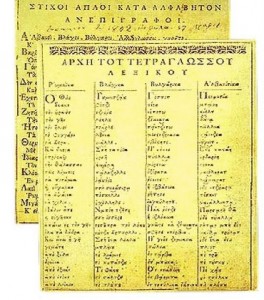
Arsâ di doauâ ori, tu cinushea-a Moscopolei dormu shi multi cãrtsâ armâneshtsâ. S-nu-agârshimu câ multi chirurâ câ furâ avinati di Patriarhia gârtseascâ di Poli, tsi nu mutrea cu oclji bunji itsi minari culturalâ faptâ tu altâ limbâ nafoarâ di greacâ.
Moscopole s-amintã iluminismulu armânescu ashi cumu ma amânatu s-amintã „Shcoala Ardeleanâ“ tu Transilvania, tsi putu s-amintâ shi s-bâneadzâ mashi cu agiutorlu a Armânjiloru moscopoleanji di Viena shi Budapesta.
Di minarea culturalâ di Moscopole s-leagâ numa anvitsatsloru: Theodor Anastasie Cavallioti, Daniil Moscopoleanlu, C-tin Ucuta, Gh.C-tin Roja, Mihail G.Boiagi, N.Ioanovici, Dim.Nicola Darvari, C-tin Emanoil Ghica de Djanfalva, Ioan Nicolidi de Pindo tsi alâsarâ cãrtsâ sinferu filosoficu, istoricu, medicalu.
THE CULTURAL MOVEMENT OF MOSCHOPOLIS
Much has been written about this movement. Unfortunately, no in-depth new research has been done on this European Balkan cultural phenomenon so far. What is its character? Is it only Greek, as the Greeks claim? How much of it was Macedonarmân, considering the fact that it was founded and developed by Macedonarmâns. And more interestingly, it is fascinating to see in this movement an initial start of the development of the European spirit in the Balkans. Just as Byzantium was not only Greek, although Greek was the language of writing, likewise, the cultural movement of Moschopolis could not bear witness to only one culture. Moschopolis gave birth to a multicultural movement. Macedonarmân, Greek, Albanian, and Slavic cultures lived together here . All scholars were Macedonarmân though! They became aware of the need of communication, of a spiritual togetherness of all Balkan peoples. For this modern European Balkan spirit was Moschopolis highly recommended by so many foreign scholars from the West!
Under the aegis of the New Academy (Nea Academia) and conducted by the great Macedonarmân scholar Theodor Anastasie Cavalioti, Macedonarmân books were published in Moschopolis‘ printing house. The work at the typography started in 1740 and lasted for two years. Many church books were printed. Weigand said that: „The birth of this typography in the 18th century in the Ottoman Empire should not make us wonder. We know how big and rich Moschopolis was at that time and how much its commerce, industries, and science were developed there. According to George Constantin Roja, many Macedonarmân books had been printed there, but none have been found so far“.
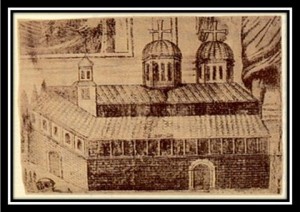 Professor Max Demeter Peyfuss, who has written one of the most important books on Macedonarmâns, „Die Aromunische Frage“ (Vienna, 1972) is one of those scholars who has been doing research for many years in order to find out and bring to light the activity of Moschopolis‘ typography.
Professor Max Demeter Peyfuss, who has written one of the most important books on Macedonarmâns, „Die Aromunische Frage“ (Vienna, 1972) is one of those scholars who has been doing research for many years in order to find out and bring to light the activity of Moschopolis‘ typography.
In the cultural movement of Moschopolis we can distinguish two directions: one that was trying to teach the Macedonarmâns only Greek and the other one which was promoting education in their mother tongue as well. Moschopolis was set on fire twice, and many of the books printed there vanished in its ashes forever. The books written in Macedonarmân were hated and chased by the Patriarchy at Constantinople, who believed there was only one God’s language to be committed to writing – Greek.
Moschopolis was the birthplace of the Macedonarmân Enlightenment just as later on „The Ardealean School“ in Transilvania was be the birthplace for the Romanian Enlightenment, whose birth and development happened only with the help of the Moscopolean Macedonarmâns living in exile in Vienna and Budapest. Names of learned people such as Th. Anastasie Cavallioti, Daniil of Moschopolis, Constantin Ucuta, George Constantin Roja, Mihail G. Boiagi, N. Ioanovici, Dimitri Nicola Darvari, Constantin Emanoil Ghica of Djanfalva, Ioan Nicolidi of Pindu, who left books of major interest for philosophy, history, and science, are linked with the cultural movement of Moschopolis.






